Content
- 1 Cochia species and varieties
- 2 Cochia planting and care in the open field
- 3 Fertilizer for cochia
- 4 Pruning kochia
- 5 Cochia growing from seed
- 6 Kochia pests
- 7 Application and useful properties
- 8 Secrets of growing kochia
- 9 The use of kohija in landscape design
- 10 Kokhia varieties
- 11 Kohia: planting and care
- 12 Cochia: growing from seed
- 13 Cochia bushes care
- 14 Conclusion
Cochia is an ornamental annual shrub, popularly considered a cypress tree, due to the similarity in the structure of the leaves. This plant is used not only as a decoration, but also for the manufacture of brooms. Moreover, the use of the plant as a material for brooms was previously the only reason for growing. But thanks to the fruitful work of breeders, decorative species appeared that change their color with the onset of autumn.
Due to the fact that kochia has dense shoots, which, moreover, grow very quickly, the crown can be given a different shape during pruning. And some species of this shrub, with the arrival of autumn, change the color of their leaves to bright orange and red-pink shades.
Cochia species and varieties
Kohia Venichnaya - one of the most common decorative types. Among its varieties, the following can be noted: cochia hairy and Childs... Their main difference is that the hairy one puts on red shades with the approach of autumn, and the second one remains green.
Cochia Creeping - less decorative appearance. Reaches about 5-6 cm in height, has a thicker base, and the rest of the branches spread in different directions along the ground. Grows on rocky slopes and in sandy steppes.
Cochia woolly-flowered - an annual plant, reaching half a meter in height, has reddish or yellowish-green shoots with curly hairs. Prefers sandy soils.
Cochia Dense-flowered - an annual shrub, more than a meter in height. The flowers are covered with many small whitish hairs, which gives the impression of a furry bush.
Kohia Jade - a fast-growing shrub that is great for curly molding in flower beds. Reaches a meter height with proper care and sufficient fertilization.
Kohia Sultan - this one-year compact rounded dwarf shrub, well shaped. In height it reaches 80-100 cm. Closer to autumn, there is a change of emerald shades of leaves to red (burgundy).
Cochia Acapulco Silver - has green leaves with silvery tips, which turn purple in autumn.
Cochia Green Lace - characterized by a more elongated, oval bush with emerald green leaves.
Cochia Green Forest - an annual elongated bush with a bright green color of leaves throughout the growing season, therefore it is called “green Forest"(Translated from English).
Cochia Skoparia - an annual heat-loving shrub that does not have a very pronounced flowering, but the leaves acquire a copper-red tint in the fall.
Cochia Berning Bush - this unusual variety, which has a red color already with the emergence of seedlings.
to the table of contents
Cochia planting and care in the open field
As much as I would not like to have this plant all year round - nevertheless, the kochia is an annual and attempts to grow it in pots will most likely end in failure. Open ground only.
Planting and caring for a kochia is not a big deal. It is necessary to choose warm time for planting, i.e. not in early spring (return frosts are not permissible, they can destroy the rudiments of sowing).But she is not afraid of drought, she can easily survive, for some time without moisture, but without fanaticism, since the kohija can lose its decorative effect and the process of wilting will begin. It is best to provide moderate but frequent watering.
During planting, it is necessary to take into account the fact that this is a bush that loves freedom, therefore the distance between seedlings (seedlings) or other neighboring plants should be at least 30 cm.Otherwise, you can get a skinny, sluggish or dried broom.
Irezine is also a representative of the Amaranth family, is easily grown when planted in the open field, and with its decorative foliage can decorate any home plot. You can find advice on growing and care in this article.
to the table of contents
Fertilizer for cochia
The shrub prefers sunny areas with fertilized soil. Planting in acidic and waterlogged soils is not permissible. In addition, the land around the shrub must be loose, which is ensured by periodic weeding.
Fertilizers are applied several times, the density and brightness of the foliage and the general condition of the kochia will depend on this. The first time a complex mineral fertilizer is applied a week after planting in open ground, and the second - a month later. It is also advisable to feed the bush during the growing season and after pruning (molding) with nitrogen fertilizers.
to the table of contents
Pruning kochia
Kohia tolerates pruning very well, so you can let your imagination run wild and experiment. And due to the fact that the plant grows very quickly, you can change its shape every 2-3 weeks.
to the table of contents
Cochia growing from seed
Cochia propagates by seeds, which can be sown directly into open ground, or pre-grow seedlings in a greenhouse. At the same time, do not forget that the time for this should be chosen warm: if immediately into open soil, then not earlier than April. But for seedlings it is possible and earlier - March, and in the ground already in April-May.
When sowing seeds in open ground, you may need to cover them with foil on top. In this case, the air temperature should not be lower than + 16 ° С.
The seedlings planted in the greenhouse are in more favorable conditions, safe and at a constant temperature. Seedlings appear in two weeks, and, at first, they grow very slowly, and then catch up with growth.
Seedlings do not dive, but are immediately planted in the soil, maintaining a distance of 30-50 cm from each other. But the seedlings obtained with direct planting (immediately into the soil) must be thinned out, keeping all the same distance.
to the table of contents
Kochia pests
The most dangerous parasite for kohija is considered spider mite... Therefore, in case of detection of this pest, it is necessary to promptly carry out the treatment with special preparations, for example, Neoron solution (1 ml / 1 l of water). Repeat the course in two weeks.
to the table of contents
Application and useful properties
Kochia not only decorates gardens, flower beds, alleys and much more, but is also used in medicine. The plant has the following properties: cardiac stimulation, diuretic and diaphoretic effect, as well as general tonic effect. It is used during diseases of the urinary tract and bladder, eczema, rheumatism, edema and skin inflammation. Cochia-based ointments treat skin and nail diseases.
In addition, some use the leaves of the plant in cooking various dishes, but mainly as a herb for livestock. The upper shoots with flowers are used as dried flowers, and the dried stems are used for brooms, as mentioned earlier.
to the table of contents
Kohia is rapidly gaining popularity among amateur flower growers and professional landscape designers. Why do they love this culture, which blooms with nondescript small flowers that do not carry decorative value? The flowers are barely visible, hiding in the leaf axils. Kohia is definitely not grown for flowers. The leaves are thin, long, delicate, and by themselves, they are also not highly decorative.In addition, kochia is also an annual, that is, it has to be grown from seeds every year. Nevertheless, it is a popular plant that can be found on every other site today.
Cochia seed growing when to plant
Secrets of growing kochia
Cochia can be grown through seedlings or by sowing directly into the ground. In general, there are many varieties bred in culture. They differ mainly in size and color. Some have bright green leaves that turn red by autumn. Some have intense light green foliage that later turns dark green. There are varieties in which the leaves turn orange.
Red cochia
Sowing seedlings
The timing of sowing kochia seeds for further growing seedlings depends on the climate of your area.
At the end of March, you can start sowing in a standard Central Russian climate, when the last date for the threat of frost on the soil is the beginning of May.
Cochia seeds
- Prepare containers. The depth of the containers is at least 12 cm, the optimal dimensions are 25x25 or rectangular - 20x40.
- Containers must be thoroughly disinfected. To do this, they are washed under hot water with laundry soap, then additionally rinsed with an intensive solution of potassium permanganate.
- It is better to prepare the soil yourself from fine peat and river fine sand. You can add perlite and some humus.
- The soil is disinfected before planting - by heating or with a hot solution of potassium permanganate.
- The soil is leveled, compacted with a board, moistened.
Compaction of soil before sowing
- Compaction of soil before sowing
- The seeds are sparsely and evenly distributed over the top.
- Be sure to sprinkle on top with a very thin layer of sand.
- Moisten with a spray bottle.
- Cover with a protective white cloth (lutrasil).
Covered Seeds with Lutrasil
- Covered Seeds with Lutrasil
- Put on light and temperature + 18 ° С… + 20 ° С.
Video - Growing cochia from seeds
Seedling care
Seedlings appear on the eighth - tenth day. The protective material is removed. Immediately it is worth moving the containers in a room with a temperature 3-5 degrees lower. Maximum + 16 ° С. The sprouts must be carefully watered, along the edge of the container, avoiding overflow. Seedlings of kochia are susceptible to disease of all seedlings - black leg - to a greater extent.
To protect green sprouts from disease, it is necessary to maintain the specified temperature, not allowing it to rise. Watering the seedlings is carried out in moderation, especially if the room is humid.
Advice! The soil in the container should not dry out - the seedlings will immediately droop and the leaves will begin to wither. With aerated soil and good drainage in the container, it is advisable to water young plants twice a week.
Disease - black leg
If, nevertheless, a black leg happened, and you find diseased specimens with characteristic spots and darkening on the leg, you must:
- remove diseased plants;
- stop watering the container;
- sprinkle the soil with dry sand, which will absorb some of the excess moisture.
When the soil dries up, the next watering should be done with a weak solution of potassium permanganate.
If the blackleg continues to spread, the seedlings will have to dive into dry, fresh, disinfected soil.
Kokhia seedling picking
To obtain compact seedlings that are not stretched out excessively, they need to be dived in 2-3 weeks, in the phase of three sheets, in a personal container of 2-3 pieces. Pick pots should be up to 10 cm in diameter.
After the pick, the temperature of the content is the same, the place is the lightest, watering in the same mode, top dressing.
The first feeding with a complex of fertilizers with a predominance of nitrogen one week after the dive and then every 10-14 days.
Disembarkation at the very end of May. You need to choose a place for kokhia that is sunny, where there is no wind, calm. The soil should be moderately fertile, not waterlogged, loose.The distance between seedlings when planting on flowerbeds and rabatki is up to 30 cm, with curb cultivation in the form of a hedge - 10-15 cm.
Kohiyu is grown in a sunny, windless place
During the rooting period of seedlings, the plant needs increased watering and the next feeding, two weeks after planting. When carrying out haircuts, it is imperative to feed the plants every time after the procedure.
Sowing in the ground
If you don't want to mess with seedlings, you can grow kochia by sowing in the ground. For the successful emergence and development of seedlings, several conditions must be precisely observed.
- Wait for the right temperature. The air should warm up during the day to + 18 ° С, and at night to the level of + 12 ° С not less. This usually does not happen until May.
- The site for sowing kochia must be prepared by carefully loosening the soil, if necessary, add dolomite flour for deoxidation.
Loosening the ground before planting
- Moisten the soil to a depth of 5 cm. Lightly tamp.
- Sowing in the morning or evening, not thickly, on top. Sprinkle with fine soil or sand in a very thin layer.
- Sprinkle gently with water. Cover with nonwoven fabric to protect and shelter plants. It is impossible to cover the cochia with a film - the seeds must receive air.
On the open ground, seeds germinate one and a half times longer than in a container for seedlings. Seedlings can be thin and unpresentable. Subsequently, the weak must be removed, leaving a distance of 20-35 cm between the bushes.If you grow a decorative border from kochia, the distance between the plants can be reduced to 10-15 cm.
On the open ground, seeds germinate one and a half times longer
At night, when the temperature drops below + 10 ° C, the plants must continue to be covered.
Outdoor care
Taking care of seedlings outdoors is not much different from taking care of seedlings. It is necessary to water intensively, trying, nevertheless, so that the plants do not rot and get sick. In an adult form, the kochia is relatively drought-resistant, but nevertheless, it should not be allowed to dry out the soil, so that the foliage - the main "property" of the plant - does not lose its decorative effect.
In the flowerbed, it is imperative to weed kochii
In the flowerbed, it is imperative to weed the plants, and loosen the soil, especially in the early stages of the growing season. You can mulch the soil between the bushes with rare planting with decorative stones, bark and other mulching materials.
At least twice a summer, you need to feed the kochia with a complex of minerals, in which nitrogen has a large proportion.
Cochia must be pruned so that the branches grow evenly. Also, it can be given any shape - it obeys an artistic haircut well.
Kohia needs to be pruned
The use of kohija in landscape design
| Solitary landing | As single accent, for example on the lawn or among low ground cover |
| Group landing | In groups on a flower bed or a rabatka or in a mixborder for a background row |
| Alpine slide or rockery | Near large stones or in small groups |
| Curb landing | As a border for a flower bed, along paths, like a hedge |
| Topiary | Single planting followed by crown formation in topiary style |
Cochia can be sown not only in spring but also in autumn. For winter sowing, flower beds are prepared in October. Sowing is superficial, with a little dusting. It is important not to sow before October so that the seeds do not start growing until spring. It is especially convenient to sow kohija in winter to create curbs.
Cochia in landscape design
Cochia seeds have a short germination period. 50% "survive" with proper storage up to two years, but the standard shelf life is limited to a year. It is best to sow fresh plant seeds that you can harvest yourself from female specimens. They are located in seed pods, and if they are not removed in time, the plant will multiply by self-sowing. With continuous group plantings in a flower bed, self-seeding reproduction may come in handy.With the onset of spring and the appearance of sprouts, it will only be enough to thin out so that the plants do not oppress each other.
During the cold autumn, the kohija quickly withers and dies. The decorative effect can be extended by moving the plants into containers. On the balcony, the kohija will turn green for another 1.5-2 months, before the onset of severe frosts.
When the plants are dry, they can be used to create flower arrangements and dry compositions. Traditionally, kohija was used as a regular broom.
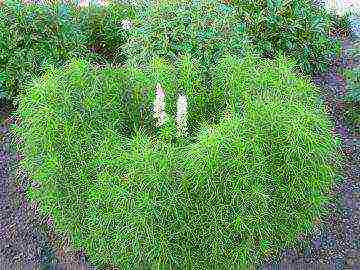
Cochia is a beautiful ornamental plant, whose homeland is China. Today culture is in great demand in many countries. This name was given to kochia in honor of the famous German biologist Koch. By the outward appearance of the plant, one might think that the bush belongs to the conifer family, because even among the people it was nicknamed the annual cypress, but if you touch the plant, it becomes clear that its branches are quite soft and tender.
Description and varieties
There are about 80 species in the genus Kokhia. Only some species can be planted on the territory of Russia:
- Coronal. This plant is distinguished by its unpretentious care and drought tolerance. The bushes of the crown cochia are spherical. In autumn, the plant acquires a red-burgundy color. The peculiarity of the culture is that it is able to withstand even slight frosts, so you can enjoy the external beauty of the bush even in late autumn. But how the red volcano is grown from Lobelia seeds, this article will help you understand.
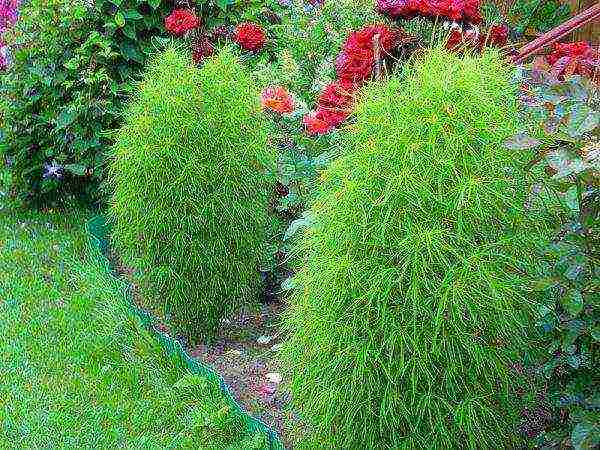
Kokhia Venechnaya
- Hairy... This bush is distinguished by its slenderness and a height of up to 1 m. Its leaves are narrow and lowered down. Their color is light green, but in the fall they acquire a burgundy color. It is necessary to plant the plant in areas where the sun is present. In this case, the soil can be depleted. How the planting and leaving of Iberis evergreen occurs, and how this plant looks in the photo, can be seen in this article.
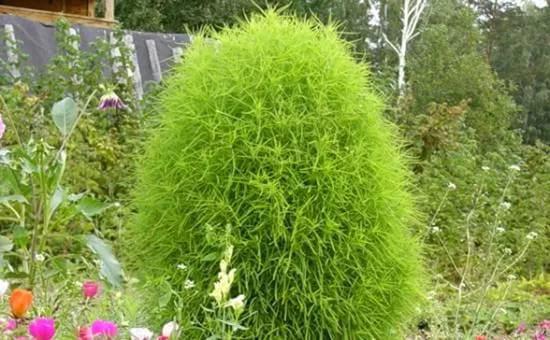
Hairy
- Kohia Childs... Bushes are compact and spherical. Their height reaches 50 cm. They are covered with green foliage, which does not change color throughout the year. But how beautiful the Forsythia shrub looks will help to understand the photo and information from this article.

Childs
In addition to the presented types of kochia, breeders today were able to breed some varieties of an ornamental plant:
- Sultan. The culture forms slender bushes 70-100 cm high. Leaves can change their color throughout the year, becoming burgundy. The variety tolerates a haircut well.
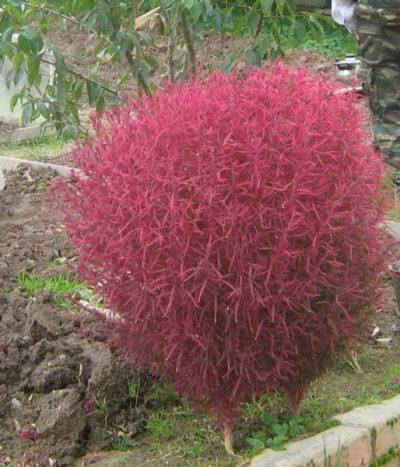
Sultan
- Acapulco Silver... The bushes are spherical in shape, and the twigs are covered with green leaves, along the edges of which have a silvery edging. With the onset of autumn, they change their color to crimson. But how the planting and leaving of the spherical thuja takes place is described in great detail here in the article.
- Nephritis. This plant is distinguished by its rapid growth. Its height can reach 1 m. It is worth using the variety to create green sculptures.
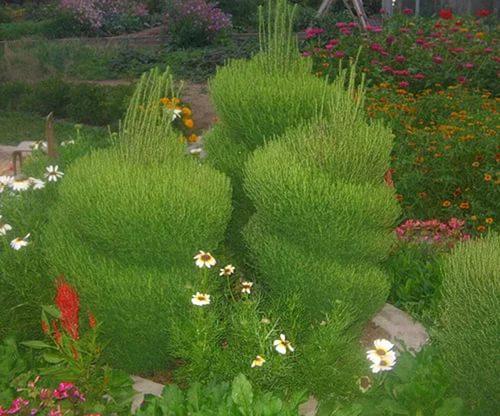
Nephritis
- Flame... An annual plant that takes on a columnar shape as it grows. Its height reaches 80-100 cm. In autumn, the leaves change their green color to crimson. The variety is resistant to minor frosts, but how it is grown from the seeds of Scabiosa annual can be seen in this video.

Flame
- Shilzy... Bushes have dense foliage. Crown height reaches 1 m. Green leaves begin to change their color to purple-red in summer.

Shilzy
How and when to plant
To get the maximum germination of kochia seeds, as well as the full development of young shoots, you need to know some rules for planting a plant. Despite the fact that this annual does not require increased attention to itself, under certain conditions its development is impossible.
You may also be interested in learning about how growing from the seeds of Alyssum rocky occurs.
Planting seeds in open ground
The considered ornamental culture is not frost-resistant, so it does not tolerate frost well. So planting seeds in open soil can only take place if the air temperature is 18-19 degrees. At the same time, the temperature should not be lower than 10 degrees at night. So sowing the seeds of kochia is due in May.
When the planting material has been purchased, it remains to prepare a place for planting. Degree and semi-desert are considered the natural habitat of Kokhia.
This must be taken into account when choosing a place for kochii in your garden plot. The plant does not like shade, so it is necessary to plant the plant in an area that is well illuminated by the sun's rays. At the same time, the soil should be non-acidic and well-drained. Before sowing seeds, the soil must be fertilized, loosened and moistened.
On the video - kochia from seeds:
You can get excellent seedlings only if they are not more than 2 years old. Planting should be done in the morning or evening. Sow seeds thinly. Scatter them on the selected area, and then sprinkle with earth. Then be sure to moisten the soil. Cover the top with a non-woven material so that the air there does not finally warm up. Weak shoots must then be removed. And leave a distance of 20-30 cm between the plants.
Growing seedlings
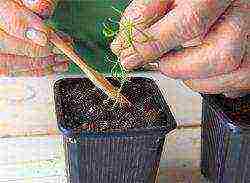
If you live in an area with a cold climate, then sowing seeds immediately into open soil is not worth it. First you need to grow seedlings. You need to sow seeds in a box in March-April. At the same time, seedlings should grow in a well-lit place, otherwise the sprouts will turn out to be long and thin. To plant seeds, you need to fill the box with a mixture of peat, humus and sand. But before that, disinfect the substrate by placing it in the oven.
Before sowing, it is worth tamping the ground and moistening well. Now take the planting material and spread it over the surface of the earth. Sprinkle a little sand on top. It is not necessary to press the seeds too deeply. Now spray them with water from a spray bottle. As a result, cover the container with lutrasil or other material that will not allow light and air to pass through.
Already on the 7-10th day, the first shoots will appear. Now you can remove the shelter permanently. So that the seedlings are not affected by dangerous diseases, it is worth watering it regularly, but in moderation.
But the temperature regime in the room should be reduced by several degrees. If signs of the disease have formed on some sprouts, then they should be urgently removed, and the soil should be neutralized with potassium permanganate solutions.
When 3 leaves are formed on the seedlings, then it is worth making a pick. To do this, transplant the saplings into separate containers. Their diameter should not be higher than 10 cm. Further, the plant must be abundantly irrigated and provided with sunlight. 7 days after the pick, it is worth feeding the seedlings. Further, similar events should be held every 2 weeks.
Before planting seedlings in open ground, you should wait until there is a steady heat. As a rule, this is mid-May. To get a lush and beautiful bush, you need to provide the seedlings with moderate watering and excellent lighting. A month after planting, top dressing is to be done.
How to care

In order for the plants to be compact in size, you need to dive them. This is done after 2-3 leaves are formed. Subsequent care is reduced to moderate watering, fertilization. At the same time, it is worth making them every week and using mineral dressings. When caring for cochia, it is necessary that the soil is nutritious and loose.
Cochia is a drought-resistant crop, therefore, it is unpretentious to care for. Additional irrigation should be carried out at the time of rooting and during severe drought. The culture develops best in the first summer months. So in a month it is necessary to apply complex fertilizers a couple of times.
Cochia is a very beautiful and original plant.Its peculiarity is in its unusual appearance. If you look at it from a long distance, you get the feeling that it is a small Christmas tree, but if you touch it, that the leaves are incredibly soft and tender. Adhering to simple rules for growing and caring, you can decorate a flower garden in a beautiful and original way. Read also about the Zinnia flower.
 To help a park or garden look original and beautiful, it is often necessary to use not only traditional plants. Annual cypresses provide a good effect. Among gardeners, they are also known as kochia, which has many advantages. Many people appreciate it for its unpretentiousness and lack of strict requirements for the landing site. Such a destructive operation for many plants as pruning and forming a bush does not in any way affect the further development of the kochia, since this plant gains leaf mass in a fairly short time.
To help a park or garden look original and beautiful, it is often necessary to use not only traditional plants. Annual cypresses provide a good effect. Among gardeners, they are also known as kochia, which has many advantages. Many people appreciate it for its unpretentiousness and lack of strict requirements for the landing site. Such a destructive operation for many plants as pruning and forming a bush does not in any way affect the further development of the kochia, since this plant gains leaf mass in a fairly short time.
Cypress is usually planted in late spring. In this case, when creating favorable conditions, this annual can grow up to 1 m in height... From the point of view of landscape design, kohija is attractive in that it retains a beautiful columnar shape. Many people like it with a neat crown, which is why it is perceived by many gardeners as a miniature cypress.
Kokhia varieties
Sometimes this plant, which is widely used in landscape design, is called broom kochia, for which there is a completely logical explanation. The fact is that once this plant was cultivated to obtain brooms for household needs. However, as interest in kochia increased, a large number of new varieties appeared, distinguished by a variety of color palette of foliage. Therefore, today, to decorate the site, you can use cypress trees of a lettuce, emerald green, pinkish and almost purple hue, choosing from them the one that best correlates with the general style of decorating the territory.
Kohia is one of the brightest representatives of the Marev family. In fact she is a shrub, as indicated by its stems, which are juicy and flexible in every area. In the wild, kochia is represented in southern Europe, Australia, North and South America. Because of this, it is difficult to talk about where this plant first appeared. In the process of development, it forms a large number of branches, which are decorated with narrow leaves attached to individual branches.
There are quite unique varieties of kochia, which begin to transform in the fall: at this time of the year, instead of their usual color, the leaves acquire a purple hue. From this, the kochia retains a very bright and decorative appearance until the first frost. Some plant varieties, even with a cold snap, do not lose their juicy greenery, which also makes them very elegant. If you pay attention to the flowers, then they do not stand out with pronounced decorative properties, since they are located in the axils of the foliage and are hidden from sight.
Kohia: planting and care
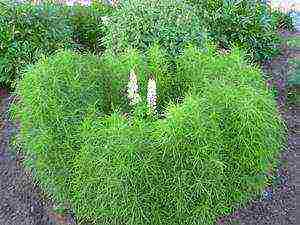 Observations show that this plant feels better. in steppe and semi-desert conditions... Therefore, if you want to grow kochia summer cyprus in your garden, then it is advisable to place it in sunny areas. And it's good if they are open. If the kochiya remains without moisture for some time, it will not do much harm to it. The consequences may be completely different if it grows in conditions of stagnant water or good drainage is not provided for it before planting.
Observations show that this plant feels better. in steppe and semi-desert conditions... Therefore, if you want to grow kochia summer cyprus in your garden, then it is advisable to place it in sunny areas. And it's good if they are open. If the kochiya remains without moisture for some time, it will not do much harm to it. The consequences may be completely different if it grows in conditions of stagnant water or good drainage is not provided for it before planting.
The owner does not have to worry about feeding to provide the bushes with the necessary nutrients. On almost any soil, kohija feels good, the only exceptions are acidic ones. Therefore, this moment must be taken into account when choosing a place for sowing seeds and transplants of adult seedlings... However, if you want the bushes to reach their maximum size during the cultivation process, it is recommended to apply fertilizer to the soil during planting.
Landing features
Plants should be placed at a distance of at least 30 cm, or even better, if it is increased to 50. In this case, during the first stage of growth, the kochia will spend all its energy on a set of vegetative mass and only after that it will enter the flowering phase. At this point, it stops growing. Due to the lack of free space for growth, the process of bud formation begins, which makes it difficult for the flowers to acquire a beautiful, natural shape.
Cochia summer cyprus to the number of cold-resistant crops, therefore, it is necessary to plan its planting not earlier than the first ten days of May. However, if you are anxious to quickly enjoy its flowering, then you can start growing seedlings.
But you can choose another method - sowing seeds in open ground. However, in this case, you will have to protect the planting from frost.
Cochia: growing from seed
The easiest way to get beautiful and large cochia bushes is start growing it in a greenhouse... In this case, you will have the opportunity to place the bushes in the way you want when planting. Usually, when sowing, all seeds germinate, and young bushes when transplanted show excellent survival rate.
-
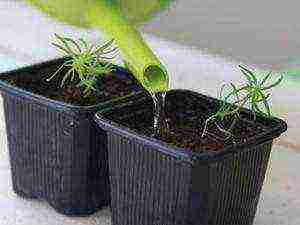 if you decide to grow seedlings in boxes, then it is recommended to adhere to the following placement scheme - 15-20 cm between plants. Cochia is prone to self-seeding, which requires the owner to track the moment when the seeds reach the stage of ripening. After collecting, the seeds remain viable for a long time, therefore, if you store them in a dark and dry place, you can increase the representation of this plant in your area in a couple of years;
if you decide to grow seedlings in boxes, then it is recommended to adhere to the following placement scheme - 15-20 cm between plants. Cochia is prone to self-seeding, which requires the owner to track the moment when the seeds reach the stage of ripening. After collecting, the seeds remain viable for a long time, therefore, if you store them in a dark and dry place, you can increase the representation of this plant in your area in a couple of years; - if you decide to sow seeds directly into the greenhouse, then you should provide good lighting in it. Therefore, during sowing, it is enough to gently press the soil into them. Since the seeds are very small in size, thinning is often necessary after emergence. For rapid growth of seedlings, it is necessary to ensure regular watering, and also after 10 days from the moment of planting, fertilize with universal fertilizers;
- although the kochia needs frequent watering, the portions of water should be small, which is especially important during the active growing season. Watering can be completed at the moment when the crown of the bushes is fully formed. Mature plants tolerate long periods of drought well, but they can be seriously damaged by sudden cold snaps. Therefore, if you decide to grow perennial varieties of kokhia on your site, then you will have to cover the bushes while preparing them for winter.
Cochia bushes care
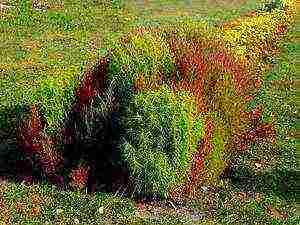 If you decide to immediately sow seeds in open ground, then you will have to watering frequentlyespecially in the first months of growth. This is very important, because it is at this time that the formation of the vegetative mass occurs. At other stages of development, plants are undemanding to care. They respond well to weeding, as this allows an increase in the amount of air supplied.
If you decide to immediately sow seeds in open ground, then you will have to watering frequentlyespecially in the first months of growth. This is very important, because it is at this time that the formation of the vegetative mass occurs. At other stages of development, plants are undemanding to care. They respond well to weeding, as this allows an increase in the amount of air supplied.
The second feeding is usually planned a month after germination. At this time it is recommended apply mineral fertilizers... If you create favorable conditions for growth, then the bush takes about a month and a half to reach its maximum height, and from this moment the crown formation process begins. Kohia summer cyprus tolerates a haircut without consequences, so it can be regularly given the necessary shape.
At the end of the next pruning under the bush, it is recommended to apply nitrogen fertilizers. It is also helpful to feed the plants with liquid nutrient solutions. Although she can do without them, however, such fertilizers also have a good effect on her condition.If you constantly feed Kokhia summer Cyprus, then she can easily endure a haircut carried out every two weeks.
Kochia is liked by many gardeners because resistant to many diseases... Although it cannot cope with some pests, for example, a spider mite. When signs of infection are found, it is often necessary to use special drugs. Since this plant consists of dense foliage, then for her spraying is useful, which is recommended to be carried out twice a season with an interval of two weeks.
It is usually enough to look at the plant to understand what it needs most.
- if the plant does not have enough moisture, then its foliage will wilt, and this will certainly affect the attractiveness of the plant. To remedy this situation, you need to water as soon as possible - usually this allows you to return the decorative properties to the bushes.
- if the problem is related to a deficiency of nutrients, then the cochia begins to fade, its color loses its former beauty. The way out in this situation can be the introduction of liquid fertilizers.
Preparing for winter
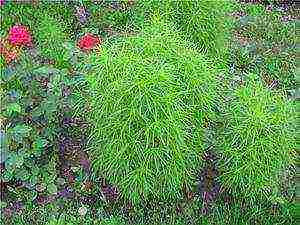 Since the kochia is an annual plant, it is dug up in the fall, thus preparing a place for planting the plants next year. For sheltering perennial varieties, you can use any available materials, combining them with the shortening of the crown. A favorable moment for opening in spring is the period when frosts pass. For central Russia, this moment usually occurs in mid-May.
Since the kochia is an annual plant, it is dug up in the fall, thus preparing a place for planting the plants next year. For sheltering perennial varieties, you can use any available materials, combining them with the shortening of the crown. A favorable moment for opening in spring is the period when frosts pass. For central Russia, this moment usually occurs in mid-May.
Cochia amazes many with its pronounced decorative properties, so it can often be found in gardens and parks. Moreover, it remains in demand also because it is not difficult to grow it in various conditions. But at the same time, you still have to carry out certain activities:
- first of all, it is necessary to monitor the absence of weeds near it;
- you also need to prevent the appearance of flowers and other cultivated plants between the bushes;
- if there is enough free space near the root zone, then this will create an excellent opportunity for the formation of a crown, which can acquire a perfectly symmetrical shape.
Conclusion
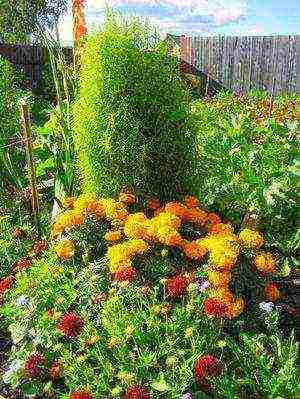 Many owners of suburban areas often want to see in their garden not only plants familiar to our country, but also rather original specimens. Therefore, the choice of many of them often falls on the kohija. This annual culture fully justifies their decision, since does not create problems with cultivation and leaving. A clear confirmation is that today kohija can be found not only in gardens, but also in parks.
Many owners of suburban areas often want to see in their garden not only plants familiar to our country, but also rather original specimens. Therefore, the choice of many of them often falls on the kohija. This annual culture fully justifies their decision, since does not create problems with cultivation and leaving. A clear confirmation is that today kohija can be found not only in gardens, but also in parks.
In general, the high interest in the plant, which is regularly used in landscape design, is due to its unpretentious care. After all, the main difficulties arise only with the cultivation of young seedlings. Adult plants can often do without moisture without losing their attractiveness. The only thing that needs to be taken care of is protection from a cold snap, as this can greatly harm the plant.
Cochia plant
Rate the article:
(5 votes, average: 4.2 out of 5)


